《数据结构》程序填空复习题
数据结构程序填空题
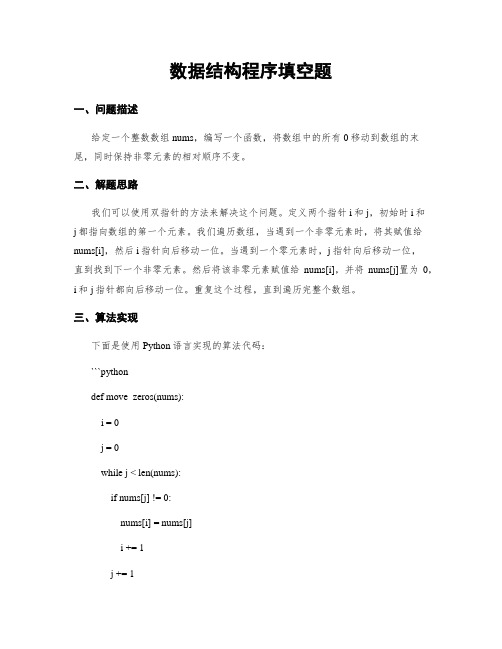
数据结构程序填空题一、问题描述给定一个整数数组nums,编写一个函数,将数组中的所有0移动到数组的末尾,同时保持非零元素的相对顺序不变。
二、解题思路我们可以使用双指针的方法来解决这个问题。
定义两个指针i和j,初始时i和j都指向数组的第一个元素。
我们遍历数组,当遇到一个非零元素时,将其赋值给nums[i],然后i指针向后移动一位。
当遇到一个零元素时,j指针向后移动一位,直到找到下一个非零元素。
然后将该非零元素赋值给nums[i],并将nums[j]置为0,i和j指针都向后移动一位。
重复这个过程,直到遍历完整个数组。
三、算法实现下面是使用Python语言实现的算法代码:```pythondef move_zeros(nums):i = 0j = 0while j < len(nums):if nums[j] != 0:nums[i] = nums[j]i += 1j += 1while i < len(nums):nums[i] = 0i += 1return nums```四、算法分析1. 算法的时间复杂度为O(n),其中n是数组的长度。
我们需要遍历整个数组一次。
2. 算法的空间复杂度为O(1),我们只需要使用常数级别的额外空间。
五、示例测试我们可以对算法进行一些示例测试,以验证其正确性。
示例1:输入:[0, 1, 0, 3, 12]输出:[1, 3, 12, 0, 0]解释:将所有的0移动到数组的末尾,同时保持非零元素的相对顺序不变。
示例2:输入:[0, 0, 0, 0, 0]输出:[0, 0, 0, 0, 0]解释:数组中所有元素都是0,不需要进行任何操作。
示例3:输入:[1, 2, 3, 4, 5]输出:[1, 2, 3, 4, 5]解释:数组中没有0,不需要进行任何操作。
六、总结本文介绍了如何将一个整数数组中的所有0移动到数组的末尾,同时保持非零元素的相对顺序不变。
我们使用双指针的方法来解决这个问题,通过遍历数组,将非零元素移动到数组的前部分,然后将剩余的位置填充为0。
数据结构程序填空题
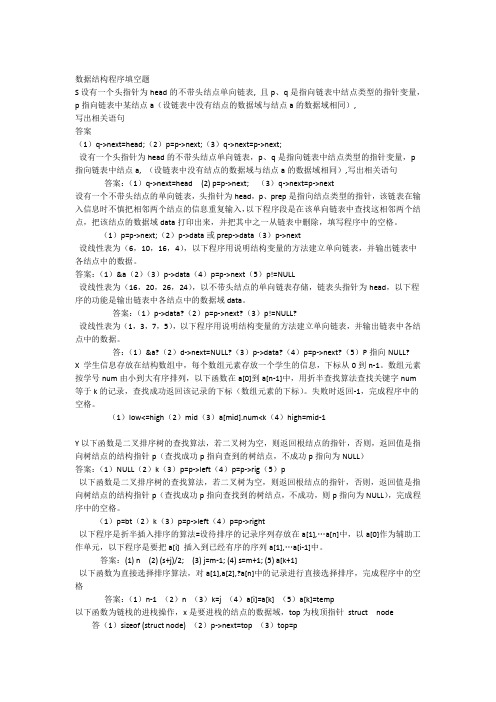
数据结构程序填空题S设有一个头指针为head的不带头结点单向链表, 且p、q是指向链表中结点类型的指针变量,p指向链表中某结点a(设链表中没有结点的数据域与结点a的数据域相同),写出相关语句答案(1)q->next=head;(2)p=p->next;(3)q->next=p->next;设有一个头指针为head的不带头结点单向链表,p、q是指向链表中结点类型的指针变量,p指向链表中结点a, (设链表中没有结点的数据域与结点a的数据域相同),写出相关语句答案:(1)q->next=head (2) p=p->next; (3)q->next=p->next设有一个不带头结点的单向链表,头指针为head,p、prep是指向结点类型的指针,该链表在输入信息时不慎把相邻两个结点的信息重复输入,以下程序段是在该单向链表中查找这相邻两个结点,把该结点的数据域data打印出来,并把其中之一从链表中删除,填写程序中的空格。
(1)p=p->next;(2)p->data或prep->data(3)p->next设线性表为(6,10,16,4),以下程序用说明结构变量的方法建立单向链表,并输出链表中各结点中的数据。
答案:(1)&a(2)(3)p->data(4)p=p->next(5)p!=NULL设线性表为(16,20,26,24),以不带头结点的单向链表存储,链表头指针为head,以下程序的功能是输出链表中各结点中的数据域data。
答案:(1)p->data?(2)p=p->next?(3)p!=NULL?设线性表为(1,3,7,5),以下程序用说明结构变量的方法建立单向链表,并输出链表中各结点中的数据。
答:(1)&a?(2)d->next=NULL?(3)p->data?(4)p=p->next?(5)P指向NULL?X 学生信息存放在结构数组中,每个数组元素存放一个学生的信息,下标从0到n-1。
数据结构程序填空题
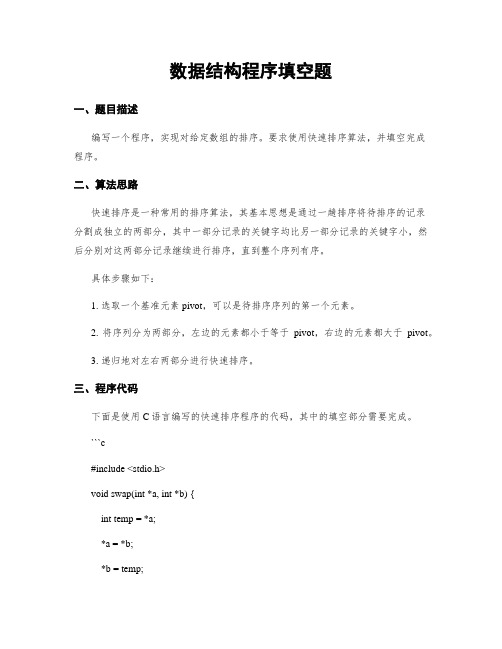
数据结构程序填空题一、题目描述编写一个程序,实现对给定数组的排序。
要求使用快速排序算法,并填空完成程序。
二、算法思路快速排序是一种常用的排序算法,其基本思想是通过一趟排序将待排序的记录分割成独立的两部分,其中一部分记录的关键字均比另一部分记录的关键字小,然后分别对这两部分记录继续进行排序,直到整个序列有序。
具体步骤如下:1. 选取一个基准元素pivot,可以是待排序序列的第一个元素。
2. 将序列分为两部分,左边的元素都小于等于pivot,右边的元素都大于pivot。
3. 递归地对左右两部分进行快速排序。
三、程序代码下面是使用C语言编写的快速排序程序的代码,其中的填空部分需要完成。
```c#include <stdio.h>void swap(int *a, int *b) {int temp = *a;*a = *b;*b = temp;int partition(int arr[], int low, int high) {int pivot = arr[low];int i = low, j = high + 1;while (1) {while (arr[++i] < pivot && i < high);while (arr[--j] > pivot);if (i >= j) {break;}swap(&arr[i], &arr[j]);}swap(&arr[low], &arr[j]);return j;}void quickSort(int arr[], int low, int high) { if (low < high) {int pivotIndex = partition(arr, low, high); quickSort(arr, low, pivotIndex - 1);quickSort(arr, pivotIndex + 1, high);}int main() {int arr[] = {9, 5, 2, 7, 1, 8, 3};int n = sizeof(arr) / sizeof(arr[0]);printf("Original array: ");for (int i = 0; i < n; i++) {printf("%d ", arr[i]);}printf("\n");quickSort(arr, 0, n - 1);printf("Sorted array: ");for (int i = 0; i < n; i++) {printf("%d ", arr[i]);}printf("\n");return 0;}```四、程序运行结果运行以上程序,输出结果如下:```Original array: 9 5 2 7 1 8 3Sorted array: 1 2 3 5 7 8 9```五、算法分析快速排序算法的时间复杂度为O(nlogn),其中n为待排序序列的长度。
数据结构程序填空题

数据结构程序填空题一、题目描述编写一个程序,实现对数据结构的填空操作。
程序需要实现以下功能:1. 创建一个数据结构,用于存储整数类型的数据。
2. 实现向数据结构中插入数据的功能。
3. 实现从数据结构中删除指定数据的功能。
4. 实现查找数据结构中指定数据的功能。
5. 实现显示数据结构中所有数据的功能。
二、程序设计1. 数据结构设计我们选择使用链表作为数据结构,每一个节点包含一个整数类型的数据和一个指向下一个节点的指针。
```C++struct Node {int data;Node* next;};```2. 创建数据结构首先,我们需要定义一个指向数据结构头节点的指针,并初始化为NULL。
```C++Node* head = NULL;```3. 插入数据实现向数据结构中插入数据的功能,我们需要进行以下步骤:- 创建一个新节点,并为其分配内存。
- 将新节点的数据设置为指定的数值。
- 将新节点的指针指向当前头节点。
- 更新头节点为新节点。
```C++void insert(int value) {Node* newNode = new Node;newNode->data = value;newNode->next = head;head = newNode;}```4. 删除数据实现从数据结构中删除指定数据的功能,我们需要进行以下步骤:- 遍历链表,查找目标数据的前一个节点。
- 将前一个节点的指针指向目标数据的下一个节点。
- 释放目标数据节点的内存。
```C++void remove(int value) {Node* current = head;Node* previous = NULL;while (current != NULL && current->data != value) { previous = current;current = current->next;}if (current != NULL) {if (previous != NULL) {previous->next = current->next;} else {head = current->next;}delete current;}}```5. 查找数据实现查找数据结构中指定数据的功能,我们需要进行以下步骤:- 遍历链表,查找目标数据。
数据结构程序填空题
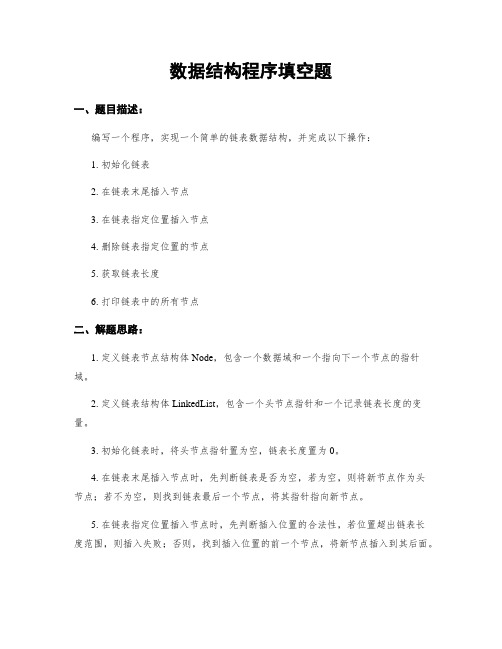
数据结构程序填空题一、题目描述:编写一个程序,实现一个简单的链表数据结构,并完成以下操作:1. 初始化链表2. 在链表末尾插入节点3. 在链表指定位置插入节点4. 删除链表指定位置的节点5. 获取链表长度6. 打印链表中的所有节点二、解题思路:1. 定义链表节点结构体Node,包含一个数据域和一个指向下一个节点的指针域。
2. 定义链表结构体LinkedList,包含一个头节点指针和一个记录链表长度的变量。
3. 初始化链表时,将头节点指针置为空,链表长度置为0。
4. 在链表末尾插入节点时,先判断链表是否为空,若为空,则将新节点作为头节点;若不为空,则找到链表最后一个节点,将其指针指向新节点。
5. 在链表指定位置插入节点时,先判断插入位置的合法性,若位置超出链表长度范围,则插入失败;否则,找到插入位置的前一个节点,将新节点插入到其后面。
6. 删除链表指定位置的节点时,先判断删除位置的合法性,若位置超出链表长度范围,则删除失败;否则,找到删除位置的前一个节点,将其指针指向要删除节点的下一个节点,并释放要删除节点的内存空间。
7. 获取链表长度时,直接返回链表结构体中记录的长度变量。
8. 打印链表中的所有节点时,从头节点开始遍历链表,依次输出每个节点的数据域。
三、代码实现:```c#include <stdio.h>#include <stdlib.h>// 定义链表节点结构体typedef struct Node {int data; // 数据域struct Node* next; // 指针域} Node;// 定义链表结构体typedef struct LinkedList {Node* head; // 头节点指针int length; // 链表长度} LinkedList;// 初始化链表void initLinkedList(LinkedList* list) {list->head = NULL; // 头节点指针置为空list->length = 0; // 链表长度置为0}// 在链表末尾插入节点void insertAtEnd(LinkedList* list, int value) {Node* newNode = (Node*)malloc(sizeof(Node)); // 创建新节点newNode->data = value; // 设置新节点的数据域newNode->next = NULL; // 设置新节点的指针域为NULL if (list->head == NULL) {list->head = newNode; // 若链表为空,将新节点作为头节点} else {Node* current = list->head;while (current->next != NULL) {current = current->next; // 找到链表最后一个节点}current->next = newNode; // 将最后一个节点的指针指向新节点}list->length++; // 链表长度加1}// 在链表指定位置插入节点void insertAtPosition(LinkedList* list, int value, int position) {if (position < 0 || position > list->length) {printf("插入位置不合法!\n");return;}Node* newNode = (Node*)malloc(sizeof(Node)); // 创建新节点newNode->data = value; // 设置新节点的数据域if (position == 0) {newNode->next = list->head; // 若插入位置为0,将新节点作为头节点 list->head = newNode;} else {Node* current = list->head;for (int i = 0; i < position - 1; i++) {current = current->next; // 找到插入位置的前一个节点}newNode->next = current->next; // 将新节点的指针指向插入位置的节点 current->next = newNode; // 将插入位置的前一个节点的指针指向新节点}list->length++; // 链表长度加1}// 删除链表指定位置的节点void deleteAtPosition(LinkedList* list, int position) {if (position < 0 || position >= list->length) {printf("删除位置不合法!\n");return;}Node* temp;if (position == 0) {temp = list->head; // 记录要删除的节点list->head = list->head->next; // 将头节点指向下一个节点} else {Node* current = list->head;for (int i = 0; i < position - 1; i++) {current = current->next; // 找到删除位置的前一个节点}temp = current->next; // 记录要删除的节点current->next = current->next->next; // 将删除位置的前一个节点的指针指向删除位置的后一个节点}free(temp); // 释放要删除节点的内存空间list->length--; // 链表长度减1}// 获取链表长度int getLength(LinkedList* list) {return list->length;}// 打印链表中的所有节点void printLinkedList(LinkedList* list) { Node* current = list->head;while (current != NULL) {printf("%d ", current->data);current = current->next; // 遍历链表 }printf("\n");}int main() {LinkedList list;initLinkedList(&list);insertAtEnd(&list, 1);insertAtEnd(&list, 2);insertAtEnd(&list, 3);printf("链表中的节点:");printLinkedList(&list); // 链表中的节点:1 2 3insertAtPosition(&list, 4, 1);printf("链表中的节点:");printLinkedList(&list); // 链表中的节点:1 4 2 3deleteAtPosition(&list, 2);printf("链表中的节点:");printLinkedList(&list); // 链表中的节点:1 4 3int length = getLength(&list);printf("链表的长度:%d\n", length); // 链表的长度:3 return 0;}```四、测试结果:运行以上代码,输出结果为:```链表中的节点:1 2 3链表中的节点:1 4 2 3链表中的节点:1 4 3链表的长度:3```五、总结:通过以上程序的实现,我们成功地完成了一个简单的链表数据结构,并实现了初始化链表、在链表末尾插入节点、在链表指定位置插入节点、删除链表指定位置的节点、获取链表长度以及打印链表中的所有节点等操作。
数据结构复习题及参考答案

《数据结构》课程复习资料一、填空题:1.设需要对5个不同的记录关键字进行排序,则至少需要比较________次,至多需要比较__________次。
2.设二叉排序树的高度为h,则在该树中查找关键字key最多需要比较_________次。
3.设在长度为20的有序表中进行二分查找,则比较一次查找成功的结点数有_________个,比较两次查找成功有结点数有_________个。
4.数据结构从逻辑上划分为三种基本类型:___________、__________和___________。
5.在一个具有n个顶点的无向完全图中,包含有________条边,在一个具有n个顶点的有向完全图中,包含有________条边。
6.向一棵B_树插入元素的过程中,若最终引起树根结点的分裂,则新树比原树的高度___________。
7.在堆排序的过程中,对任一分支结点进行筛运算的时间复杂度为________,整个堆排序过程的时间复杂度为________。
8.在快速排序、堆排序、归并排序中,_________排序是稳定的。
9.在有n个叶子结点的哈夫曼树中,总结点数是_______。
10.一棵树T采用二叉链表存储,如果树T中某结点为叶子结点,则在二叉链表BT中所对应的结点一定_______。
11.3.已知数组A[10][10]为对称矩阵,其中每个元素占5个单元。
现将其下三角部分按行优先次序存储在起始地址为1000的连续的内存单元中,则元素A[5,6]对应的地址是_______。
12.在有n个结点的无向图中,其边数最多为_______。
13.取出广义表A=(x,(a,b,c,d))中原子x的函数是_______。
14.对矩阵采用压缩存储是为了___ ____。
15.带头结点的双循环链表L为空表的条件是_______。
16.设线性表中元素的类型是实型,其首地址为1024,则线性表中第6个元素的存储位置是。
17.对于顺序存储的栈,因为栈的空间是有限的,在进行运算时,可能发生栈的上溢,在进行运算时,可能发生栈的下溢。
数据结构程序填空题
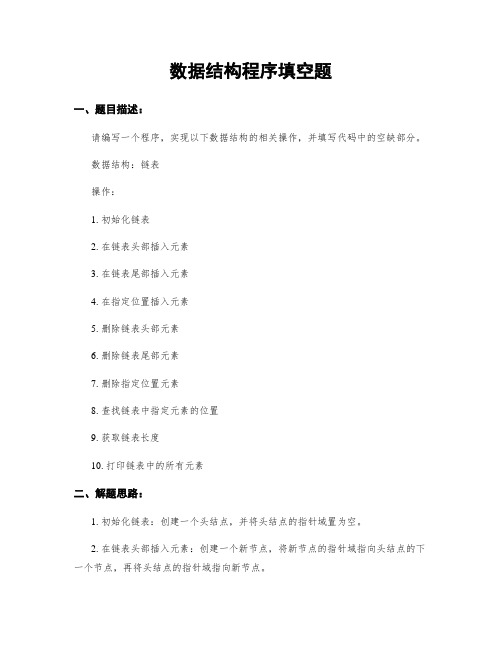
数据结构程序填空题一、题目描述:请编写一个程序,实现以下数据结构的相关操作,并填写代码中的空缺部分。
数据结构:链表操作:1. 初始化链表2. 在链表头部插入元素3. 在链表尾部插入元素4. 在指定位置插入元素5. 删除链表头部元素6. 删除链表尾部元素7. 删除指定位置元素8. 查找链表中指定元素的位置9. 获取链表长度10. 打印链表中的所有元素二、解题思路:1. 初始化链表:创建一个头结点,并将头结点的指针域置为空。
2. 在链表头部插入元素:创建一个新节点,将新节点的指针域指向头结点的下一个节点,再将头结点的指针域指向新节点。
3. 在链表尾部插入元素:创建一个新节点,遍历链表找到最后一个节点,将最后一个节点的指针域指向新节点。
4. 在指定位置插入元素:创建一个新节点,遍历链表找到指定位置的前一个节点,将新节点的指针域指向前一个节点的下一个节点,再将前一个节点的指针域指向新节点。
5. 删除链表头部元素:将头结点的指针域指向头结点的下一个节点。
6. 删除链表尾部元素:遍历链表找到倒数第二个节点,将倒数第二个节点的指针域置为空。
7. 删除指定位置元素:遍历链表找到指定位置的前一个节点,将前一个节点的指针域指向指定位置的下一个节点。
8. 查找链表中指定元素的位置:遍历链表,逐个比较节点的值与指定元素的值,直到找到匹配的节点,返回其位置。
9. 获取链表长度:遍历链表,计数器加一,直到遍历到链表尾部。
10. 打印链表中的所有元素:遍历链表,逐个打印节点的值。
三、代码实现:```pythonclass ListNode:def __init__(self, val=0, next=None):self.val = valself.next = nextclass LinkedList:def __init__(self):self.head = ListNode()def insert_at_head(self, val):new_node = ListNode(val)new_node.next = self.head.nextself.head.next = new_nodedef insert_at_tail(self, val):new_node = ListNode(val)curr = self.headwhile curr.next:curr = curr.nextcurr.next = new_nodedef insert_at_position(self, val, position): new_node = ListNode(val)curr = self.headfor _ in range(position):curr = curr.nextnew_node.next = curr.nextcurr.next = new_nodedef delete_at_head(self):if self.head.next:self.head.next = self.head.next.nextdef delete_at_tail(self):curr = self.headwhile curr.next.next:curr = curr.nextcurr.next = Nonedef delete_at_position(self, position): curr = self.headfor _ in range(position):curr = curr.nextcurr.next = curr.next.nextdef find_position(self, val):curr = self.head.nextposition = 0while curr:if curr.val == val:return positioncurr = curr.nextposition += 1return -1def get_length(self):curr = self.head.nextlength = 0while curr:curr = curr.nextlength += 1return lengthdef print_list(self):curr = self.head.nextwhile curr:print(curr.val, end=" ")curr = curr.nextprint()# 测试代码linked_list = LinkedList()linked_list.insert_at_head(3) linked_list.insert_at_head(2) linked_list.insert_at_head(1) linked_list.insert_at_tail(4) linked_list.insert_at_position(5, 2) linked_list.delete_at_head() linked_list.delete_at_tail()linked_list.delete_at_position(1)print("链表中元素的位置:", linked_list.find_position(4))print("链表的长度:", linked_list.get_length())print("链表中的元素:", end="")linked_list.print_list()```四、运行结果:链表中元素的位置: 2链表的长度: 3链表中的元素:1 3 4五、解题总结:本题通过使用链表数据结构和相应的操作方法,实现了对链表的初始化、插入、删除、查找、获取长度和打印等功能。
数据结构程序填空题

程序填空题C语言基础1.下列程序的功能是输出一个整数x的绝对值。
将程序补充完整,填在空内。
#include <stdio.h>main(){ int x, ;scanf("%d",&x);y= ;printf("%d\n",y);}2. 以下程序的功能是:输出a、b、c三个变量中的最小值,请填空。
main(){ int a,b,c,t1, ;scanf("%d%d%d",&a,&b,&c);t1=a<b?a:b;t2= ;printf("%d\n",t2);}3. 下列程序的功能是将值为三位正整数的变量x中的数值按照个位、十位、百位的顺序拆分并输出。
将程序补充完整,填在空内。
#include <stdio.h>main(){ int =123;printf("%d,%d,%d\n", ,x/10%10,x/100);}4. 下列程序的功能是输出一个整数x的绝对值。
将程序补充完整,填在空内。
#include <stdio.h>main(){ int x, ;scanf("%d",&x);y= ;printf("%d\n",y);}5. 下列程序的功能是实现两个变量x和y的值的交换。
将程序补充完整,填在空内。
main(){ int x=10, =20;x+=y;y=x-y;;printf("\n%d,%d",x,y);}6. 下列程序的功能是实现两个变量x 和y 的值的交换。
main(){ int =10,y=20;x+=y;y=x-y;;printf("\n%d,%d",x,y);}分支语句1. 根据以下函数关系,对输入的x 值,计算出相应的y 值。
电大《数据结构(本)》复习题及答案
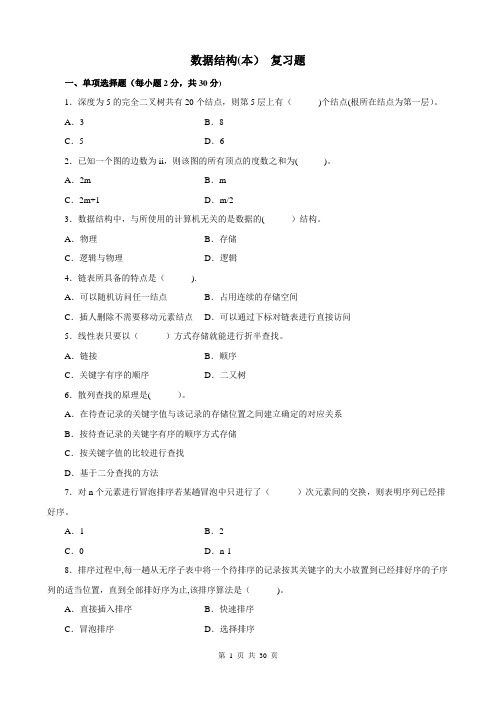
数据结构(本)复习题一、单项选择题(每小题2分,共30分)1.深度为5的完全二叉树共有20个结点,则第5层上有()个结点(根所在结点为第一层)。
A.3 B.8C.5 D.62.已知一个图的边数为ii,则该图的所有顶点的度数之和为( )。
A.2m B.mC.2m+1 D.m/23.数据结构中,与所使用的计算机无关的是数据的( )结构。
A.物理B.存储C.逻辑与物理D.逻辑4.链表所具备的特点是().A.可以随机访问任一结点B.占用连续的存储空间C.插人删除不需要移动元素结点D.可以通过下标对链表进行直接访问5.线性表只要以()方式存储就能进行折半查找。
A.链接B.顺序C.关键字有序的顺序D.二又树6.散列查找的原理是( )。
A.在待查记录的关键字值与该记录的存储位置之间建立确定的对应关系B.按待查记录的关键字有序的顺序方式存储C.按关键字值的比较进行查找D.基于二分查找的方法7.对n个元素进行冒泡排序若某趟冒泡中只进行了()次元素间的交换,则表明序列已经排好序。
A.1 B.2C.0 D.n-18.排序过程中,每一趟从无序子表中将一个待排序的记录按其关键字的大小放置到已经排好序的子序列的适当位置,直到全部排好序为止,该排序算法是()。
A.直接插入排序B.快速排序C.冒泡排序D.选择排序9.在对一组元素(64,48,106,33,25,82,70,55,93)进行直接插入排序时,当进行到要把第7个元素70插入到已经排好序的子表时,为找到插人位置,需进行()次元素n的比较(指由小到大排序).A.6 B.2C.3 D.410.采用顺序查找法对长度为n的线性表进行查找(不采用表尾设监视哨的方法),最坏的情况下要进行()次元素间的比较。
A.n+2 B.nC.n—1 D.n/211如图,若从顶点a出发按广度优先搜索法进行遍历,则可能得到的顶点序列为()。
A.acebdgf B.abecdgfC.acfedgb D.abecfdg12.元素2,4,6,8按顺序依次进栈,则该栈的不可能输出序列是( )(进栈出栈可以交替进行).A.8,6,4,2 B.2,4,6,8C.4,2,8,6 D.8,6,2,413.排序方法中,从未排序序列中挑选元素,并将其依次放人已排序序列(初始为空)的一端的方法,称为( )排序.A.归并B.插人C.选择D.快速I4.一棵哈夫曼树总共有23个结点,该树共有()个叶结点(终端结点)。
数据结构程序填空题
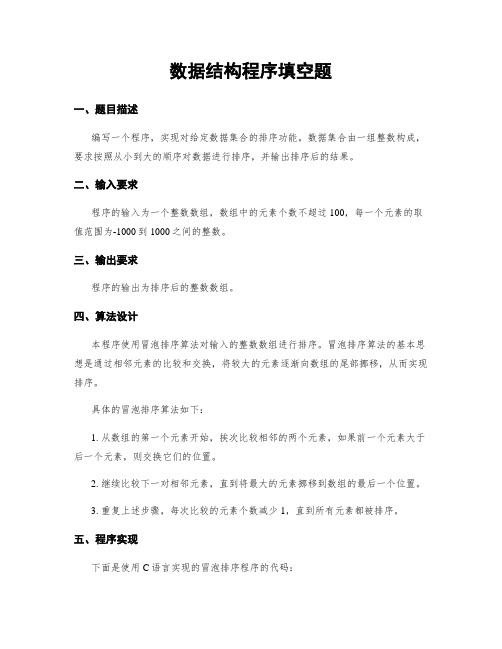
数据结构程序填空题一、题目描述编写一个程序,实现对给定数据集合的排序功能。
数据集合由一组整数构成,要求按照从小到大的顺序对数据进行排序,并输出排序后的结果。
二、输入要求程序的输入为一个整数数组,数组中的元素个数不超过100,每一个元素的取值范围为-1000到1000之间的整数。
三、输出要求程序的输出为排序后的整数数组。
四、算法设计本程序使用冒泡排序算法对输入的整数数组进行排序。
冒泡排序算法的基本思想是通过相邻元素的比较和交换,将较大的元素逐渐向数组的尾部挪移,从而实现排序。
具体的冒泡排序算法如下:1. 从数组的第一个元素开始,挨次比较相邻的两个元素,如果前一个元素大于后一个元素,则交换它们的位置。
2. 继续比较下一对相邻元素,直到将最大的元素挪移到数组的最后一个位置。
3. 重复上述步骤,每次比较的元素个数减少1,直到所有元素都被排序。
五、程序实现下面是使用C语言实现的冒泡排序程序的代码:#include <stdio.h>void bubbleSort(int arr[], int n) {int i, j, temp;for (i = 0; i < n-1; i++) {for (j = 0; j < n-i-1; j++) {if (arr[j] > arr[j+1]) {temp = arr[j];arr[j] = arr[j+1];arr[j+1] = temp;}}}}int main() {int arr[] = {5, 2, 8, 1, 9};int n = sizeof(arr) / sizeof(arr[0]); bubbleSort(arr, n);printf("排序后的数组:");for (int i = 0; i < n; i++) {printf("%d ", arr[i]);return 0;}```六、程序运行结果经过冒泡排序算法的处理,程序将输出排序后的数组。
数据结构 程序填空题
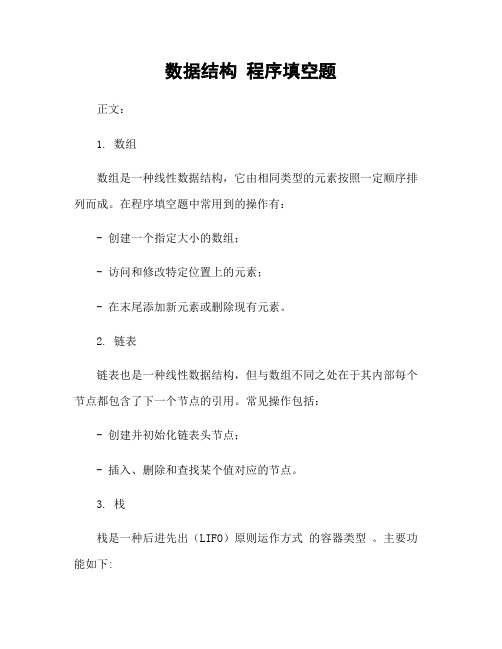
数据结构程序填空题正文:1. 数组数组是一种线性数据结构,它由相同类型的元素按照一定顺序排列而成。
在程序填空题中常用到的操作有:- 创建一个指定大小的数组;- 访问和修改特定位置上的元素;- 在末尾添加新元素或删除现有元素。
2. 链表链表也是一种线性数据结构,但与数组不同之处在于其内部每个节点都包含了下一个节点的引用。
常见操作包括:- 创建并初始化链表头节点;- 插入、删除和查找某个值对应的节点。
3. 栈栈是一种后进先出(LIFO)原则运作方式的容器类型。
主要功能如下:- 入栈:将一个新项压入堆栈。
- 出站: 弹出最近插入(即最靠近堆双端) 项目,并返回该项.4. 队列队列是遵循FIFO (First-In, First-Out ) 原理工作,其中第一个放置对象称为首位; 最后存储物体被称为尾巴 . 主要功能如下 : - enqueue : 向队伍添加新对象 .- dequeue :从队伍移除并返回第二次加人.5. 散列表(哈希表)散列表使用键来访问值,在给定关键字时通过散列函数将其映射到一个索引上。
主要操作有:- 插入键值对;- 查找给定关键字的值。
6. 树树是一种非线性数据结构,由节点和边组成。
常见类型包括二叉树、平衡二叉搜索树(AVL)等。
在程序填空题中可能涉及以下操作:- 创建并初始化一棵特定类型的树;- 遍历整个数或某个子集合。
7. 图图是由顶点和边组成的非线性数据结构,在程序填空题中经常用于表示网络连接、地理位置等问题。
基本操作如下:- 添加新顶点/删除现有顶点;- 连接两个已存在的顶点 ;8. 常见算法9. 复杂度分析附件:无法律名词及注释:1) 数据保护条例 (GDPR): 是欧洲联盟为了加强公民隐私权利而制订出来的规范措施, 对处理与储存用户信息提供更多保护.2) 版权: 指作品(文字,图片,音频视频文件等 )所属作者享有独立使用 ,复制和分发该项工程或具体部分 .3) 商标 : 包含商业名称,符号,设计,以区别其他类似产品和服务的标识.。
数据结构程序填空题
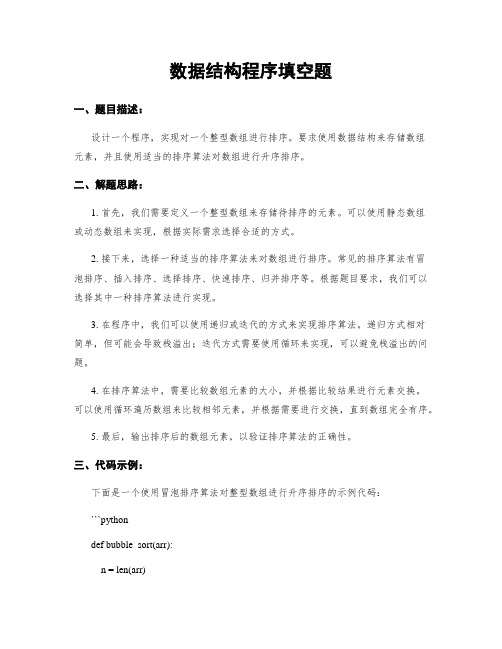
数据结构程序填空题一、题目描述:设计一个程序,实现对一个整型数组进行排序。
要求使用数据结构来存储数组元素,并且使用适当的排序算法对数组进行升序排序。
二、解题思路:1. 首先,我们需要定义一个整型数组来存储待排序的元素。
可以使用静态数组或动态数组来实现,根据实际需求选择合适的方式。
2. 接下来,选择一种适当的排序算法来对数组进行排序。
常见的排序算法有冒泡排序、插入排序、选择排序、快速排序、归并排序等。
根据题目要求,我们可以选择其中一种排序算法进行实现。
3. 在程序中,我们可以使用递归或迭代的方式来实现排序算法。
递归方式相对简单,但可能会导致栈溢出;迭代方式需要使用循环来实现,可以避免栈溢出的问题。
4. 在排序算法中,需要比较数组元素的大小,并根据比较结果进行元素交换。
可以使用循环遍历数组来比较相邻元素,并根据需要进行交换,直到数组完全有序。
5. 最后,输出排序后的数组元素,以验证排序算法的正确性。
三、代码示例:下面是一个使用冒泡排序算法对整型数组进行升序排序的示例代码:```pythondef bubble_sort(arr):n = len(arr)for i in range(n):for j in range(0, n-i-1):if arr[j] > arr[j+1]:arr[j], arr[j+1] = arr[j+1], arr[j]# 测试示例arr = [64, 34, 25, 12, 22, 11, 90]bubble_sort(arr)print("排序后的数组:")for i in range(len(arr)):print(arr[i])```四、代码说明:1. 首先,定义了一个名为`bubble_sort`的函数,该函数接受一个整型数组作为参数。
2. 在函数内部,使用两层循环来实现冒泡排序算法。
外层循环控制排序的轮数,内层循环用于比较相邻元素并进行交换。
数据结构复习题

第1章 绪论一、填空题(每空1分,共35分)1、数据结构是一门研究非数值计算的程序设计问题中计算机的 以及它们之间的 和 等的学科。
2、数据结构被形式地定义为(D, R ),其中D 是 的有限集合,R 是D 上的 有限集合。
3、数据结构按逻辑结构可分为两大类,它们分别是 和 。
若细分为4类,分别是 、 、 和 。
4、线性结构中元素之间存在 关系,树形结构中元素之间存在 关系,图形结构中元素之间存在 关系。
5、在线性结构中,第一个结点 前驱结点,其余每个结点有且只有 个前驱结点;最后一个结点 后继结点,其余每个结点有且只有 个后继结点。
6、在树形结构中,树根结点没有 结点,其余每个结点有且只有 个前驱结点;叶子结点没有后继结点,其余每个结点的后继结点数可以任意。
7、在图形结构中,每个结点的前驱结点数和后继结点数可以 。
8、数据结构包括数据的 、数据的 和数据的 这三个方面的内容。
9、数据的存储结构可用四种基本的存储方法表示,它们分别是 、 、 和 。
10、数据的运算最常用的有5种,它们分别是 、 、 、 、 。
11、一个算法的效率可分为 效率和 效率。
二、选择题(每小题1分,共5分)1、数据结构中,与所使用的计算机无关的是数据的( )结构。
A 、存储B 、物理C 、逻辑D 、物理和存储2、数据结构是指( )。
A 、数据元素的组织形式B 、数据类型C 、数据存储结构D 、数据定义3、算法分析的目的是( )。
A 、找出数据结构的合理性B 、研究算法中的输入和输出的关系C 、分析算法的效率以求改进D 、分析算法的易懂性和文档性4、算法分析的两个主要方面是:( )。
A 、空间复杂性和时间复杂性B 、正确性和简明性C 、可读性和文档性D 、数据复杂性和程序复杂性5、计算机算法指的是( )。
A 、计算方法B 、排序方法C 、解决问题的有限运算序列D 、调度方法6.某算法的语句执行频度为(3n+nlog2n+n2+8),其时间复杂度表示( )。
数据结构程序填空题
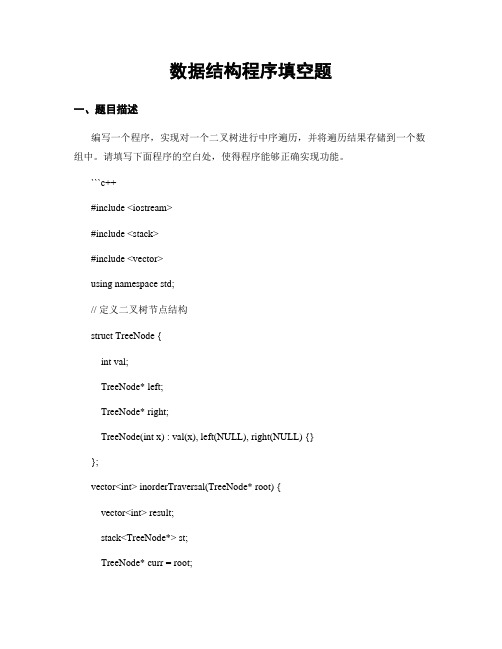
数据结构程序填空题一、题目描述编写一个程序,实现对一个二叉树进行中序遍历,并将遍历结果存储到一个数组中。
请填写下面程序的空白处,使得程序能够正确实现功能。
```c++#include <iostream>#include <stack>#include <vector>using namespace std;// 定义二叉树节点结构struct TreeNode {int val;TreeNode* left;TreeNode* right;TreeNode(int x) : val(x), left(NULL), right(NULL) {}};vector<int> inorderTraversal(TreeNode* root) {vector<int> result;stack<TreeNode*> st;TreeNode* curr = root;while (curr != NULL || !st.empty()) {if (curr != NULL) {st.push(curr);curr = curr->left;} else {curr = st.top();st.pop();result.push_back(curr->val);curr = curr->right;}}return result;}int main() {// 构造二叉树TreeNode* root = new TreeNode(1);root->right = new TreeNode(2);root->right->left = new TreeNode(3);// 中序遍历并输出结果vector<int> res = inorderTraversal(root); for (int i = 0; i < res.size(); i++) {cout << res[i] << " ";}cout << endl;return 0;}```二、解题思路本题要求实现对一个二叉树进行中序遍历,并将遍历结果存储到一个数组中。
数据结构程序填空复习题
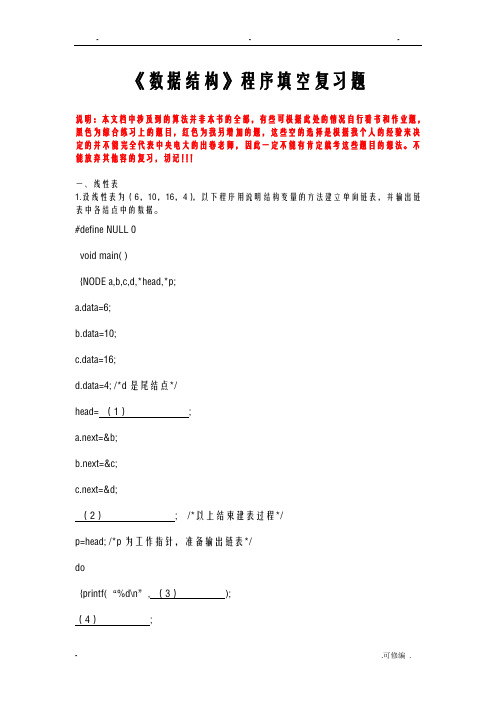
《数据结构》程序填空复习题说明:本文档中涉及到的算法并非本书的全部,有些可根据此处的情况自行看书和作业题,黑色为综合练习上的题目,红色为我另增加的题,这些空的选择是根据我个人的经验来决定的并不能完全代表中央电大的出卷老师,因此一定不能有肯定就考这些题目的想法。
不能放弃其他容的复习,切记!!!一、线性表1.设线性表为(6,10,16,4),以下程序用说明结构变量的方法建立单向链表,并输出链表中各结点中的数据。
#define NULL 0void main( ){NODE a,b,c,d,*head,*p;a.data=6;b.data=10;c.data=16;d.data=4; /*d是尾结点*/head= (1);a.next=&b;b.next=&c;c.next=&d;(2); /*以上结束建表过程*/p=head; /*p为工作指针,准备输出链表*/do{printf(“%d\n”, (3));(4);}while( (5));}答案:(1)&a(2)d next=NULL(3)p->data(4)p=p->next(5)p!=NULL2. 以下函数在head为头指针的具有头结点的单向链表中删除第i个结点,struct node{ int data;struct node *next;};typedefstruct node NODEint delete(NODE *head,int i){NODE *p,*q;int j;q=head;j=0;while((q!=NULL)&&( ___(1)_____)){___(2)_____;j++;}if(q==NULL)return(0);p= ___(3)_____;___(4)_____=p->next;free(___(5)_____);return(1);}答案:(1)j<i-1(2)q=q->next(3)q->next(4)q->next(5)p3.将新元素插入到线性表中的第i位,MAX是数组的个数,a[0]用以存放线性表长度,b存放待插入的元素值,i存放插入的位置,n存放线性表长度{int a[MAX];int i,j,b,n;scanf(“%d%d%d”,&b,&i,&n);for(j=1;j<=n;j++)scanf(“%d”,&a[j]);a[0]=n;for(j=n; (1);j- -)(2);(3);(4);for(j=1;j<=a[0];j++)printf(“%5d\n”,a[j]);}答案:(1)j>=i(2)a[j+1]=a[j](3)a[i]=b(4)a[0]=n+14.用头插法建立带头结点且有n个结点的单向链表的算法NODE *create(n){NODE *head,*p,*q;int ip=(NODE *)malloc(sizeof(NODE));(1);(2);(3);for(i=1;i<=n;i++){p=(NODE *)malloc(sizeof(NODE));p->data=i;if(i==1)(4);else{(5);(6);}}return(head);}答案:(1)head=p(2)p->next=NULL(3)q=p(4)p->next=NULL(5)p->next=q->next(6)q->next=p一、栈1. 以下函数为链栈的进栈操作,x是要进栈的结点的数据域,top为栈顶指针struct node{ ElemType data;struct node *next;};struct node *top ;void Push(ElemType x){struct node *p;p=(struct node*)malloc(___(1)_____);p->data=x;___(2)_____;}答案:(1)sizeof (struct node)(2)p->next=top(3)top=p二、队列1. 以下函数为链队列的入队操作,x为要入队的结点的数据域的值,front、rear分别是链队列的队头、队尾指针struct node{ ElemType data;struct node *next;};struct node *front,*rear;void InQueue(ElemType x){struct node *p;p= (struct node*) ___(1)_____;p->data=x;p->next=NULL;___(2)_____;rear= ___(3)_____;}答案:(1)malloc(sizeof (struct node))(2)rear->next=p(3)p2. 以下函数为链队列的出队操作(链队列带有头结点),出队结点的数据域的值由x返回,front、rear分别是链队列的队头、队尾指针struct node{ ElemType data;struct node *next;};struct node *front,*rear;ElemType OutQueue(){ElemType x;if(___(1)_____) {printf("队列下溢错误!\n");exit(1);}else {struct node *p=front->next;x=p->data;front->next= ___(2)_____;if(p->next==NULL) rear=front;free(p);___(3)_____;}}答案:(1)front= =rear(2)p->next(3)return(x)三、树1.以下程序是先序遍历二叉树的递归算法的程序,完成程序中空格部分(树结构中左、右指针域分别为left和right,数据域data为字符型,BT指向根结点)。
《数据结构》复习题
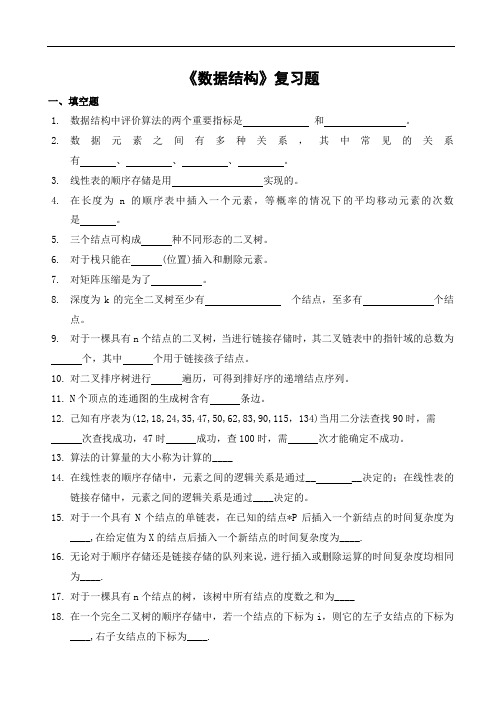
《数据结构》复习题一、填空题1.数据结构中评价算法的两个重要指标是和。
2.数据元素之间有多种关系,其中常见的关系有、、、。
3.线性表的顺序存储是用实现的。
4.在长度为n的顺序表中插入一个元素,等概率的情况下的平均移动元素的次数是。
5.三个结点可构成种不同形态的二叉树。
6.对于栈只能在 (位置)插入和删除元素。
7.对矩阵压缩是为了。
8.深度为k的完全二叉树至少有个结点,至多有个结点。
9.对于一棵具有n个结点的二叉树,当进行链接存储时,其二叉链表中的指针域的总数为个,其中个用于链接孩子结点。
10.对二叉排序树进行遍历,可得到排好序的递增结点序列。
11.N个顶点的连通图的生成树含有条边。
12.己知有序表为(12,18,24,35,47,50,62,83,90,115,134)当用二分法查找90时,需次查找成功,47时成功,查100时,需次才能确定不成功。
13.算法的计算量的大小称为计算的____14.在线性表的顺序存储中,元素之间的逻辑关系是通过__ __决定的;在线性表的链接存储中,元素之间的逻辑关系是通过____决定的。
15.对于一个具有N个结点的单链表,在已知的结点*P后插入一个新结点的时间复杂度为____,在给定值为X的结点后插入一个新结点的时间复杂度为____.16.无论对于顺序存储还是链接存储的队列来说,进行插入或删除运算的时间复杂度均相同为____.17.对于一棵具有n个结点的树,该树中所有结点的度数之和为____18.在一个完全二叉树的顺序存储中,若一个结点的下标为i,则它的左子女结点的下标为____,右子女结点的下标为____.19.对于一棵具有n个结点的二叉树,对应二叉链表中指针总数为____个,其中____个用于指向子女结点,____个指针空闲着20.以折半搜索方法搜索一个线性表时,此线性表必须是____存储的____表21.在一个无向图中,所有顶点的度数之和等于所有边数的____倍。
数据结构复习资料(题目和参考答案)

数据结构复习题及参考答案(抽考其中50%)一、单选题(每小题1分)1.下列程序段的时间复杂度为(A )。
for(i=0; i<m ; i++)for(j=0; j<t ; j++) c[i][j]=0;for(i=0; i<m ; i++)for(j=0; j<t ; j++)for(k=0; k<n ; k++)c[i][j]=c[i][j]+a[i][k]*b[k][j];(A) O(m*n*t) (B) O(m+n+t) (C) O(m+n*t) (D) O(m*t+n)2.下列程序段的时间复杂度为(A )。
i=0,s=0;while (s<n) {s=s+i ;i++;}(A) O(n 1/2) (B) O(n 1/3) (C) O(n) (D) O(n 2)3.设顺序表中有n 个数据元素,则删除表中第i 个元素需要移动(A )个元素。
(A) n-i (B) n+l-i (C) n-1-i (D) i4.设某链表中最常用的操作是在链表的尾部插入或删除元素,则选用下列(D )存储方式最节省运算时间。
(A) 单向链表 (B) 单向循环链表(C) 双向链表 (D) 双向循环链表5.设F 是由1T 、2T 和3T 三棵树组成的森林,与F 对应的二叉树为B ,1T 、2T 和3T 的结点数分别为1n 、2n 和3n ,则二叉树B 的根结点的左子树的结点数为(A )。
(A) 11n - (B) 21n - (C) 23n n + (D) 13n n +6.设指针q 指向单链表中结点A ,指针p 指向单链表中结点A 的后继结点B ,指针s 指向被插入的结点X ,则在结点A 和结点B 插入结点X 的操作序列为(B )。
(A) s->next=p->next ;p->next=-s ; (B) q->next=s ; s->next=p ;(C) p->next=s->next ;s->next=p ; (D) p->next=s ;s->next=q ;7.利用直接插入排序法的思想建立一个有序线性表的时间复杂度为(C )。
数据结构程序填空题

数据结构程序填空题标准格式文本:数据结构程序填空题数据结构是计算机科学中非常重要的概念,它涉及到如何组织和存储数据以便于高效地访问和操作。
在学习数据结构的过程中,填空题是一种常见的测试形式,它可以帮助我们巩固对数据结构的理解和应用。
以下是一道关于数据结构的填空题,通过填写合适的代码,我们可以更好地理解数据结构的实现和应用。
题目描述:假设我们需要实现一个栈(Stack)的数据结构,栈是一种先进后出(Last-In-First-Out)的数据结构。
我们可以使用数组来实现这个栈,现在请你完成其中的几个函数。
1. 初始化栈:void initStack(int *stack, int size);- 参数stack是一个指向数组的指针,用于存储栈的元素。
- 参数size表示栈的大小。
2. 判断栈是否为空:bool isEmpty(int *stack);- 参数stack是一个指向数组的指针,用于存储栈的元素。
- 返回值为true表示栈为空,返回值为false表示栈不为空。
3. 入栈操作:void push(int *stack, int size, int item);- 参数stack是一个指向数组的指针,用于存储栈的元素。
- 参数size表示栈的大小。
- 参数item表示要入栈的元素。
4. 出栈操作:int pop(int *stack);- 参数stack是一个指向数组的指针,用于存储栈的元素。
- 返回值为出栈的元素。
5. 获取栈顶元素:int top(int *stack);- 参数stack是一个指向数组的指针,用于存储栈的元素。
- 返回值为栈顶的元素,但不删除该元素。
请根据上述题目描述,填写相应的代码。
解答:1. 初始化栈:```void initStack(int *stack, int size) {for (int i = 0; i < size; i++) {stack[i] = 0; // 初始化栈中的元素为0}}2. 判断栈是否为空:```bool isEmpty(int *stack) {if (*stack == 0) {return true; // 栈顶元素为0,表示栈为空} else {return false; // 栈顶元素不为0,表示栈不为空 }}```3. 入栈操作:```void push(int *stack, int size, int item) {if (!isFull(stack, size)) { // 判断栈是否已满stack[size] = item; // 将元素item入栈size++; // 栈的大小加一} else {printf("Stack Overflow!"); // 栈已满,无法入栈 }```4. 出栈操作:```int pop(int *stack) {if (!isEmpty(stack)) { // 判断栈是否为空int item = stack[size - 1]; // 获取栈顶元素stack[size - 1] = 0; // 将栈顶元素置为0,表示删除该元素 size--; // 栈的大小减一return item; // 返回出栈的元素} else {printf("Stack Underflow!"); // 栈为空,无法出栈return -1; // 返回一个特殊值,表示出栈失败}}```5. 获取栈顶元素:```int top(int *stack) {if (!isEmpty(stack)) { // 判断栈是否为空return stack[size - 1]; // 返回栈顶元素} else {printf("Stack is Empty!"); // 栈为空,无法获取栈顶元素return -1; // 返回一个特殊值,表示获取失败}}```以上是关于栈(Stack)数据结构的填空题的标准格式文本。
- 1、下载文档前请自行甄别文档内容的完整性,平台不提供额外的编辑、内容补充、找答案等附加服务。
- 2、"仅部分预览"的文档,不可在线预览部分如存在完整性等问题,可反馈申请退款(可完整预览的文档不适用该条件!)。
- 3、如文档侵犯您的权益,请联系客服反馈,我们会尽快为您处理(人工客服工作时间:9:00-18:30)。
《数据结构》程序填空复习题说明:本文档中涉及到的算法并非本书的全部,有些可根据此处的情况自行看书和作业题,黑色为综合练习上的题目,红色为我另增加的题,这些空的选择是根据我个人的经验来决定的并不能完全代表中央电大的出卷老师,因此一定不能有肯定就考这些题目的想法。
不能放弃其他内容的复习,切记!!!一、线性表1.设线性表为(6,10,16,4),以下程序用说明结构变量的方法建立单向链表,并输出链表中各结点中的数据。
#define NULL 0void main( ){NODE a,b,c,d,*head,*p;a.data=6;b.data=10;c.data=16;d.data=4; /*d是尾结点*/head= (1);a.next=&b;b.next=&c;c.next=&d;(2); /*以上结束建表过程*/p=head; /*p为工作指针,准备输出链表*/do{printf(“%d\n”, (3));(4);}while( (5));}答案:(1)&a(2)d next=NULL(3)p->data(4)p=p->next(5)p!=NULL2. 以下函数在head为头指针的具有头结点的单向链表中删除第i个结点,struct node{ int data;struct node *next;};typedef struct node NODEint delete(NODE *head,int i ){NODE *p,*q;int j;q=head;j=0;while((q!=NULL)&&( ___(1)_____)){___(2)_____;j++;}if(q==NULL)return(0);p= ___(3)_____;___(4)_____=p->next;free(___(5)_____);return(1);}答案:(1)j<i-1(2)q=q->next(3)q->next(4)q->next(5)p3.将新元素插入到线性表中的第i位,MAX是数组的个数,a[0]用以存放线性表长度,b存放待插入的元素值,i存放插入的位置,n存放线性表长度{int a[MAX];int i,j,b,n;scanf(“%d%d%d”,&b,&i,&n);for(j=1;j<=n;j++)scanf(“%d”,&a[j]);a[0]=n;for(j=n; (1);j- -)(2);(3);(4);for(j=1;j<=a[0];j++)printf(“%5d\n”,a[j]);}答案:(1)j>=i(2)a[j+1]=a[j](3)a[i]=b(4)a[0]=n+14.用头插法建立带头结点且有n个结点的单向链表的算法NODE *create(n){NODE *head,*p,*q;int ip=(NODE *)malloc(sizeof(NODE));(1);(2);(3);for(i=1;i<=n;i++){p=(NODE *)malloc(sizeof(NODE));p->data=i;if(i==1)(4);else{(5);(6);}}return(head);}答案:(1)head=p(2)p->next=NULL(3)q=p(4)p->next=NULL(5)p->next=q->next(6)q->next=p一、栈1. 以下函数为链栈的进栈操作,x是要进栈的结点的数据域,top为栈顶指针struct node{ ElemType data;struct node *next;};struct node *top ;void Push(ElemType x){struct node *p;p=(struct node*)malloc(___(1)_____);p->data=x;___(2)_____;}答案:(1)sizeof (struct node)(2)p->next=top(3)top=p二、队列1. 以下函数为链队列的入队操作,x为要入队的结点的数据域的值,front、rear分别是链队列的队头、队尾指针struct node{ ElemType data;struct node *next;};struct node *front,*rear;void InQueue(ElemType x){struct node *p;p= (struct node*) ___(1)_____;p->data=x;p->next=NULL;___(2)_____;rear= ___(3)_____;}答案:(1)malloc(sizeof (struct node))(2)rear->next=p(3)p2. 以下函数为链队列的出队操作(链队列带有头结点),出队结点的数据域的值由x返回,front、rear分别是链队列的队头、队尾指针struct node{ ElemType data;struct node *next;};struct node *front,*rear;ElemType OutQueue(){ElemType x;if(___(1)_____) {printf("队列下溢错误!\n");exit(1);}else {struct node *p=front->next;x=p->data;front->next= ___(2)_____;if(p->next==NULL) rear=front;free(p);___(3)_____;}}答案:(1)front= =rear(2)p->next(3)return(x)三、树1.以下程序是先序遍历二叉树的递归算法的程序,完成程序中空格部分(树结构中左、右指针域分别为left和right,数据域data为字符型,BT指向根结点)。
void Preorder (struct BTreeNode *BT){ if(BT!=NULL){(1);(2);(3);}}答案:(1)printf(“%c”,BT->data)(2)Preorder(BT->left)(3)Preorder(BT->right)2. 以下程序是中序遍历二叉树的递归算法的程序,完成程序中空格部分(树结构中左、右指针域分别为left和right,数据域data为字符型,BT指向根结点)。
void Inorder (struct BTreeNode *BT){ if(BT!=NULL){(1);(2);(3);}}答案:(1)Inorder(BT->left)(2)printf(“%c”,BT->data)(3)Inorder(BT->right)3 以下程序是后序遍历二叉树的递归算法的程序,完成程序中空格部分(树结构中左、右指针域分别为left和right,数据域data为字符型,BT指向根结点)。
void Postorder (struct BTreeNode *BT){ if(BT!=NULL){(1);(2);(3);}}答案:(1)Postorder(BT->left)(2)Postorder(BT->right)(3)printf(“%c”,BT->data);四、图五、排序1.以下冒泡法程序对存放在a[1],a[2],……,a[n]中的序列进行排序,完成程序中的空格部分,其中n是元素个数,要求按升序排列。
void bsort (NODE a[ ], int n){ NODE temp;int i,j,flag;for(j=1; (1) ;j++);{flag=0;for(i=1; (2) ;i++)if(a[i].key>a[i+1].key){flag=1;temp=a[i];(3) ;(4) ;}if(flag= =0)break;}}程序中flag的功能是(5)答案:(1)j<=n-1(2)i<=n-j(3)a[i]=a[i+1](4)a[i+1]=temp(5)当某趟冒泡中没有出现交换则已排好序,结束循环2. 以下函数为直接选择排序算法,对a[1],a[2],…a[n]中的记录进行直接选择排序,完成程序中的空格typedef struct{ int key;……}NODE;void selsort(NODE a[],int n){int i,j,k;NODE temp;for(i=1;i<= ___(1)_____;i++){k=i;for(j=i+1;j<= ___(2)_____;j++)if(a[j].key<a[k].key) __(3)______;if(i!=k){temp=a[i];___(4)_____;____(5)____;}}}答案:(1)n-1(2)n(3)k=j(4)a[i]=a[k](5)a[k]=temp3.直接插入排序算法Void disort(NODE a[],int n){int I,j;NODE temp;for(i=1;i<n;i++){temp=a[i];(1);while(j>=0&&temp.key<a[j].key){(2);(3);}(4);}答案:(1)j=i-1(2)a[j+1]=a[j](3)j--(4)a[j+1]=temp4.快速排序void quicksort(NODE a[],int start,int end){int iI,j;NODE mid;if(start>=end)return;(1);(2);mid=a[i];while( (3)){while(i<j)&&a[j].key>mid.key)(4);;if( (5);){(6);;(7);;}while(i<j&&a[i].key<=mid.key)(8);;if(i<j){(9);;(10);;}}a[i]=mid;(11);;;}答案:(1)i=start(2)j=end(3)i<j(4)j-- 也可能将此条语句写出,要填写其条件中的a[j].key>mid.key(6)a[i]=a[j](7)i++(8)i++ 也可能将此条语句写出,要填写其条件中的a[i].key<=mid.key(9)a[j]=a[i](10)j--(11)quicksort(a,start,i-1)(12)quicksort(a,i+1,end)最后两句要填的概率会很高,要注意快速排序的考点很多,一般只会有三到四个空。
